|
|
|
Naturescaping is landscaping that mimics nature so that the garden will thrive without synthetic chemicals. This makes the yard a safe and healthy place for children, pets, and wildlife. Naturescaping can save time and money, as well as make the neighborhood that much more beautiful.
Naturescaping is sustainable landscaping because it does not include plants and practices
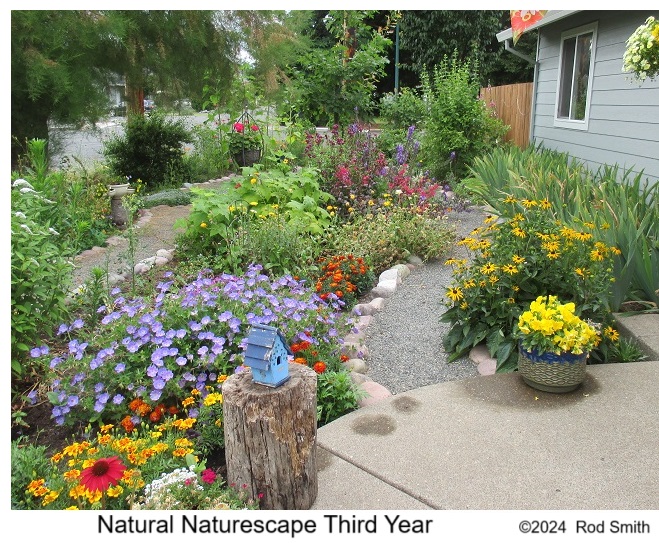 which require large amounts of water, fertilizers, pesticides, fuel and labor which manicured landscapes require. Instead, plants are chosen which will grow well in the growing conditions already present. Native plants are usually the best choices because they are already adapted to the soils and climate of the area. Once they are established after the first year, they rarely need any additional water or fertilizer. Also, they are usually less susceptible to common pests and diseases so less chemicals need to be applied. This reduces pollution as well as the cost of maintenance.
which require large amounts of water, fertilizers, pesticides, fuel and labor which manicured landscapes require. Instead, plants are chosen which will grow well in the growing conditions already present. Native plants are usually the best choices because they are already adapted to the soils and climate of the area. Once they are established after the first year, they rarely need any additional water or fertilizer. Also, they are usually less susceptible to common pests and diseases so less chemicals need to be applied. This reduces pollution as well as the cost of maintenance.
There are two approaches to Naturescaping. The conventional approach mainly substitutes native plants for non-native plants in a conventional landscape. The restoration approach seeks to restore plant communities in a naturalistic landscape as they might have been before the land was disturbed. Either approach provides the same benefits, except that the restoration approach can produce a very low maintenance landscape. Shrubs need much less pruning if they are allowed to keep a more natural appearance. Leaves do not need to be raked but can be left in planting beds for mulch. This greatly reduces noise and air pollution from blowers.
Lawns can be included where needed but should be kept to a minimum and not on slopes or in shady areas where they are hard to grow. Grass clippings should be grasscycled back into the lawn with a mulching mower.
Eco-lawns which include clover feed bees and need less fertilizer. Nitrogen fixing bacteria which live in clover roots can convert nitrogen gas from the air into ammonia which plants can use. I have not fertilized my Eco-lawn since I planted it in 2019 and it is always a healthy green.
Eco-lawns also need less water and mowing. Eco-lawns will stay green through the summer with only one inch of water applied twice a month. When the mower is set at three to four inches, Eco-lawns need to be mowed only once a month in the summer and twice a month in the spring and fall when grass grows faster. This greatly reduces labor as well as noise and air pollution.
Another advantage
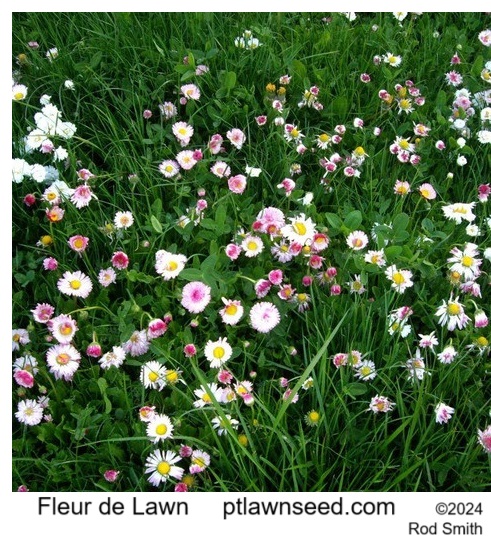 is that Naturescaping can attract wildlife back into the landscape. Many species of native plants and wildlife are slowly disappearing as their habitat is being developed into housing and commercial areas. Landscaping with native plants that provide food and shelter can attract birds, bees and butterflies back to areas where they once thrived. Attracting wildlife can be very educational for individuals and families. There are many opportunities to learn about wildlife, and discover how plants provide food and shelter to different wildlife species in different seasons. The knowledge and appreciation of nature are gifts that valuable for a lifetime. Each discovery will foster greater ecological awareness.
is that Naturescaping can attract wildlife back into the landscape. Many species of native plants and wildlife are slowly disappearing as their habitat is being developed into housing and commercial areas. Landscaping with native plants that provide food and shelter can attract birds, bees and butterflies back to areas where they once thrived. Attracting wildlife can be very educational for individuals and families. There are many opportunities to learn about wildlife, and discover how plants provide food and shelter to different wildlife species in different seasons. The knowledge and appreciation of nature are gifts that valuable for a lifetime. Each discovery will foster greater ecological awareness.
Another benefit of Naturescaping is to reduce water pollution since watering manicured landscapes often washes fertilizers and pesticides into storm sewers and into streams. It is better to capture water in a pond or rain garden so it soaks in and is available to plants. In some situations, downspouts can be disconnected and rainwater redirected to a pond or rain garden. However, rainwater should be discharged at least three feet from the house, or six feet if the house has a basement. Also, rainwater should not flow onto a neighbor's property without their permission.
Food is needed by all wildlife for survival. A landscape with plants which produce edible seeds, fruit, nuts, nectar and pollen can help feed a variety of animals. A mixture of plants is needed so food is available throughout the year for wildlife which are active all year. Plants which produce berries which remain through the winter are an important source of food for many birds and small mammals. Additional food can be provided by feeders, especially in winter if snow covers natural sources of food.
Water is
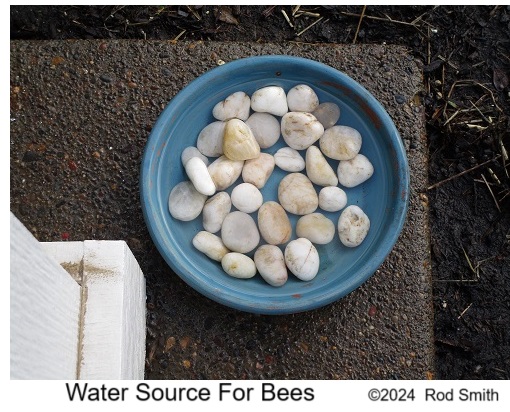 absolutely required by all life. While insects and birds which feed on berries, get a significant amount of water from their food, water is often the limiting factor in many landscapes. Adding a source of open water, such as birdbaths and ponds, will turn an average habitat into an extraordinary habitat. In addition to drinking, some birds need a water bath to keep their feathers in shape. The eggs and young of damselflies, dragonflies, frogs, toads and most salamanders need water to develop. All amphibians need moisture to keep their skin moist. A pond should have a gently sloping edge to allow wildlife to crawl in and out. Downspouts can be redirected into pond or marsh areas to catch and hold rainwater while it soaks in. This will provide habitat for additional plants and animals.
absolutely required by all life. While insects and birds which feed on berries, get a significant amount of water from their food, water is often the limiting factor in many landscapes. Adding a source of open water, such as birdbaths and ponds, will turn an average habitat into an extraordinary habitat. In addition to drinking, some birds need a water bath to keep their feathers in shape. The eggs and young of damselflies, dragonflies, frogs, toads and most salamanders need water to develop. All amphibians need moisture to keep their skin moist. A pond should have a gently sloping edge to allow wildlife to crawl in and out. Downspouts can be redirected into pond or marsh areas to catch and hold rainwater while it soaks in. This will provide habitat for additional plants and animals.
Shelter, or cover, is a place to hide from predators, rest, raise young, and avoid heat, cold and wind. Shelter is especially important for young birds and mammals which cannot flee from predators. Nearby shelter is also important while wildlife are feeding. Trees and shrubs are important forms of shelter if they are allowed to develop their natural form. Tightly clipped shrubs and hedges are too dense for birds to take shelter quickly if predators approach. Cats are the most common predator of birds, but cats will avoid Oregon grape with its prickly leaves. Other forms of shelter are brush piles, rock piles, tall grass and leaf litter. Nest boxes for bats and songbirds are also good shelter.
Space is especially needed by many birds and predatory mammals which are territorial and will chase off members of the same species. Songbirds sing to announce their claim on their territory and to warn off competing songbirds. Pileated woodpeckers cover about 300 acres to find nesting cavities and to find enough of their main food source, carpenter ants. Green spaces or the cooperation of neighbors is required to provide this much area.
An important way that populations remain stable is to produce more individuals than can survive. Some of these individual are taken as food by predators. Typically, the individuals who do not survive are diseased or weaker than the survivors. When predators disappear from a habitat, it usually produces an overabundance of their prey, which can lead to greatly increased damage to the plants they feed on.
Another example of human intervention is when exotic, non-native, wildlife or invasive plants are introduced into a habitat. They may not have the checks and balances that keep native species under control. Introduced species often compete with native species and can force native wildlife and plants out of areas where they once lived. Fortunately, one introduced species, starlings, are excellent at controlling another introduced species, craneflies.
Carrying capacity is the measure of how many individuals of each species can survive in a habitat. It depends on the size of the property, proximity to wild areas, and the availability of food, water, shelter and space. If the population of that species exceeds the carrying capacity, some individuals will leave or die. Increasing the limiting factor for that species will increase the carrying capacity. Planting plants which are known to provide food and shelter and providing feeders and nesting places will boost populations of many species.
Including a variety of plants in a landscape will provide different layers so more species will be supported. Missing layers can be provided by a neighbor's trees, but a neighbor's trees might be removed at any time.
Native plants are those which have existed in an area since before the appearance of Europeans. These plants have co-existed with bacteria, fungi, plant viruses, insects, wildlife, and other native plants for thousands of years.
Native plants generally require minimum maintenance once established when they are planted in the right conditions. They also provide a variety of colors, forms, and textures which blend in with the look of the region. There are a few exceptions. Oregon ash trees are much more disease prone than other ash trees, and native kinnikinnick is more disease prone than
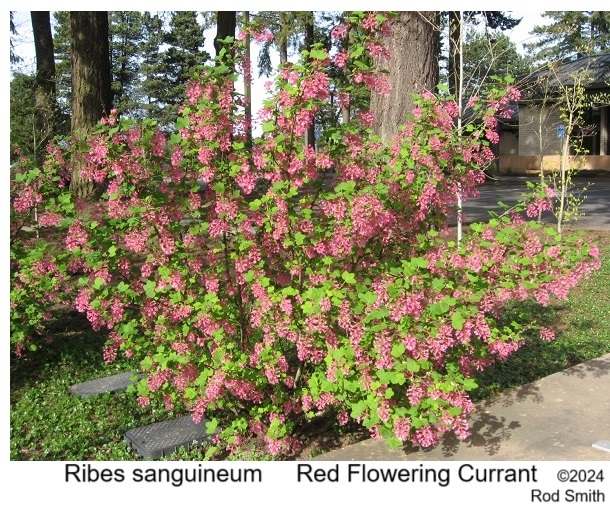 Massachusetts kinnikinnick.
Massachusetts kinnikinnick.
It is much easier to preserve existing native plants than to restore a native area. Also, native plants often have specific requirements for soil types and moisture as well as climate. Since the Pacific Northwest has many climate and soil zones, it is better to select native plants from the specific part of the region rather than just any Northwest natives. Click on Native Plant Finder for a list of plants and butterflies native to your county. However, some natives, such as Oregon grape and Douglas maples are very adaptable and can be used in areas outside their native range. Non-native plants can also be included in a landscape to increase the availability of food and shelter, but it is important to avoid plants which are known to out-compete native plants. See the list of Oregon Invasive Plants.
Area 1 is the area nearest the house, usually within thirty feet. Many newer houses on smaller lots will be mostly Area 1. Annual flower beds and lawns which require more human intervention should be placed here. This is a good place for flower beds, shrubs and small trees which provide food and shelter to attract wildlife within viewing distance. Other features for Area 1 include specialty gardens for hummingbirds and butterflies, herb or vegetable gardens which include sunflowers and other food plants for birds and beneficial insects, nest boxes for mason bees and songbirds, bird feeders, birdbath or garden pond, small brush shelter for songbirds, or a loose rock wall to provide shelter for reptiles and amphibians. For more information about designing Area 1, see the article on Landscape Design.
Area 2 has less human activity. Part or all of it might be a naturalistic landscape. It might include a layered landscape of trees, shrubs and groundcovers which attract wildlife, a hedgerow of small trees and shrubs which provide flowers and fruit at different times throughout the year, a snag or brush shelter to provide perches for songbirds or predator birds, nest boxes for bats and tree squirrels, a wild patch of grassland or ground cover, and a wildlife friendly ditch or pond.
Area 3 has the least amount of human activity and should include landscape features that need little maintenance. It should be planted with native plants that have historically been present in that local area. It may include undisturbed wild areas, a group of trees to insure future privacy, snags and rock shelters or brush shelters, a corridor of vegetation that links to a wild area on neighboring property, a foot path or blind to limit human access to sensitive wildlife areas, nest boxes for flying squirrels and for birds, such as woodpeckers and wood ducks, that need more secluded nest sites.
An easier way to begin drawing a landscape plan is to find your property on Google Maps, zoom in so the property fills the screen, switch to Satellite view, then print it out by holding down the CTRL key and pressing P for Print. This printout can then be drawn on, or scanned into Microsoft Paint or a similar program and modified digitally. This can then be used to create the Base Map.
The Base Map identifies existing wildlife features and structures. It should show all structures, hardscapes, overhead and underground utilities. Be sure to include all features which are particularly valuable to wildlife: mature trees and shrubs, especially those which provide food and shelter for wildlife, water sources of any type, major dead or partially dead trees (snags), brush and rock shelters, large stumps or logs, nest sites in trees or shrubs, existing bird feeders and birdbaths, nest boxes, burrows and runways, areas too steep or difficult to maintain, wildlife corridors including where animals go under or over a fence, and places where animals might cross a busy road.
The Schematic Landscape Plan helps identify areas of the landscape for different uses. It can be drawn on a photocopy of the Base Map or by using Paint. If a photocopy is made
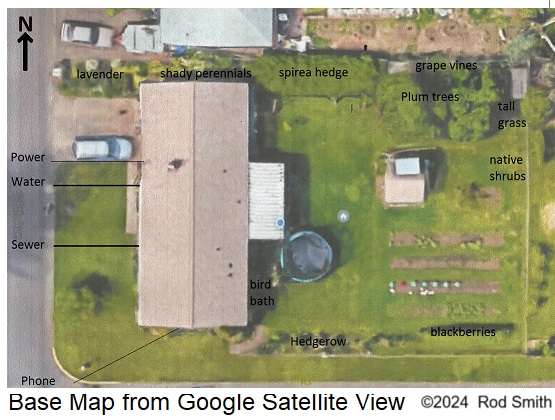 regularly or the Paint file saved under a different name regularly, and the design does not work out, then an earlier version can be used instead of starting over from the beginning. Different plans may be developed showing more space for humans or more space for wildlife, least cost or most cost, or least change and most change. Then the best ideas can be included in the final version. Investing time and thought at this stage will
save considerably more time and money later.
regularly or the Paint file saved under a different name regularly, and the design does not work out, then an earlier version can be used instead of starting over from the beginning. Different plans may be developed showing more space for humans or more space for wildlife, least cost or most cost, or least change and most change. Then the best ideas can be included in the final version. Investing time and thought at this stage will
save considerably more time and money later.
The Landscape Planting Plan shows the location of individual large plants and plant groupings of smaller plants. At this stage, more attention should be made to plant types, height, width and spacing. Plant species can be chosen later, even at the time plants are purchased. Final adjustments to any planting plan will occur at the time of planting. See the articles on Oregon Wildlife Landscape Plants and Landscape Design for more information.
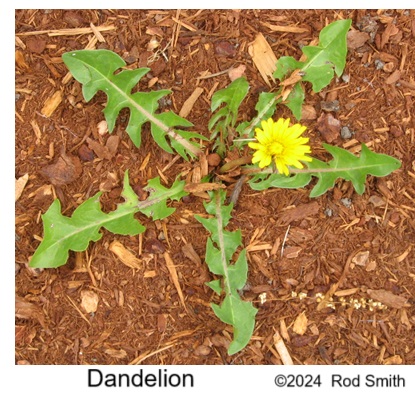 maintenance can be greatly reduced by starting right. Healthy existing plants which are beneficial to wildlife should be retained whenever possible. The right plant should be planted in the right place where it will receive the right amount of sunlight, soil moisture and has room to grow to its mature size. See the article Oregon Wildlife Landscape Plants for basic information on each plant's requirements. Plants which are suited
to their growing conditions are under less stress so they are naturally more resistant to insects and diseases. Once established, they need little more maintenance than occasional weeding, mulching, pruning and watering during prolonged dry spells. Maintenance can be reduced by planting mostly native trees, shrubs and groundcovers. Flower beds require more maintenance so they could be limited in size and planted in highly visible locations.
maintenance can be greatly reduced by starting right. Healthy existing plants which are beneficial to wildlife should be retained whenever possible. The right plant should be planted in the right place where it will receive the right amount of sunlight, soil moisture and has room to grow to its mature size. See the article Oregon Wildlife Landscape Plants for basic information on each plant's requirements. Plants which are suited
to their growing conditions are under less stress so they are naturally more resistant to insects and diseases. Once established, they need little more maintenance than occasional weeding, mulching, pruning and watering during prolonged dry spells. Maintenance can be reduced by planting mostly native trees, shrubs and groundcovers. Flower beds require more maintenance so they could be limited in size and planted in highly visible locations.
Weeding can be limited to aggressive plants which crowd out desirable plants, or plants which are of no value to wildlife. Many plants which are considered weeds in manicured landscapes actually produce seeds which are eaten by wildlife, such as lamb's quarters, chickweed, goldenrod and dandelion. Some plants provide nesting materials, such as dandelions and mullein. Other so-called weeds are able to grow in bare ground and compacted soil where garden plants will not grow. For long term weed control, plant desirable plants that will form a living mulch to cover bare ground completely. Until the plants have filled in, weeds can be controlled by mulch, hand weeding or cutting off flower stalks before problem plants produce seed.
Garden compost is the best mulch to apply to new plantings to prevent competition from weeds until plants are established. Be careful not to cover low growing branches or to bury the crown, else the lower branches and crown will be made vulnerable to diseases, insects and rodents. Mulching can be simplified by allowing fallen leaves and needles to mulch the area under plants, which is nature's way of mulching. Fallen leaves also provide habitat for insects and small animals.
Watering new plants is important for their survival until they are established. Regular watering might only be needed in Area 1, especially in flower beds. See the plant list in Oregon Wildlife Landscape Plants for water needs for each plant. Drip irrigation is the most efficient and versatile system. It is also the easiest to design and install.
Fertilizing might not be needed when appropriate plants are selected and mulched to provide nutrients. When leaves are off-color or small, a liquid organic fertilizer is best. Granular fertilizers broadcast on top of the soil are often mistaken for food by ground feeding birds.
Pruning can be kept to a minimum for wildlife plants. Shrubs retain their natural look when they are pruned with the Tug and Cut Method described in the article Pruning for Shade, Flowers and Fruit. The low skirt of branches around a conifer provides shelter. A loosely growing hedge welcomes songbirds, provides perching, nesting and protection. Fruit trees will continue to need regular pruning. The best time for pruning is in late winter after berries are gone and wildlife activity is low. Avoid pruning in late spring when birds are nesting. Branches removed during pruning can be used to build brush shelters.
Mowing can also be kept to a minimum. Eco-lawns, which include clover and flowers, need to be mowed only once a month in the summer and twice a month in spring and fall when grass grows faster. This allows flowers to provide nectar for butterflies. A taller mowing height of three or more inches reduces watering and creates habitat for insects, garter snakes and small rodents. Mowing should be timed to allow beneficial plants to flower and provide nectar and pollen for insects, but to cut off flowers of undesirable plants before they produce seeds.
Controlling harmful insects in a wildlife friendly manner means using as little pesticides as possible. Some damage is tolerable, especially in Areas 2 and 3. If you want butterflies, you have to let caterpillars feed on leaves. Plants can lose 25% of their leaves without suffering harm. Natural predators, such as songbirds, bats, amphibians, spiders, ground beetles, ladybugs, lacewings and praying mantises should be relied on for the majority of insect control. They will be slow to respond to initial outbreaks of harmful insects, but will eventually bring them under control. Plants which attract and nourish predators and beneficial insects should be included in the landscape. These plants include: Achillea Yarrow, Ajuga Carpet Bugle, Anethum Dill, Coriandrum Coriander, Daucus Queen Ann's Lace, Foeniculum Fennel, Iberis Candytuft, Leucanthemum Daisy, Linaria, Lobularia Sweet Alyssum, Melissa Lemon Balm, Mentha Mint Pennyroyal, Monarda Beebalm, Nepeta Catnip, Penstemon, Rosmarinus Rosemary, Solidago Goldenrod, Amelanchier Serviceberry, Gaultheria Salal, Mahonia Oregon Grape, Potentilla, Ribes Red Flowering Currant, Rosa Wild Rose, Sambucus Elderberry, Vaccinium Evergreen Huckleberry, Alnus Alder, Calocedrus Incense Cedar, Pseudotsuga Douglas Fir, Prunus Cherry and Rhus Sumac. For descriptions see Wildlife Landscape Plants. Common and scientific names can be found at Common and Scientific Names.
Since most pesticides also affect predators and beneficial insects, use them as sparingly as possible. Never apply weed and feed products, which require spreading pesticides over large areas. Spot spray only where pests are causing damage. A product containing spinosad, such as Captain Jack's Dead Bug Brew, is the least harmful to beneficial insects although it is effective on a limited number of harmful insects. Be sure to identify the harmful insects which are causing damage and read the label to see if spinosad is effective.
Nesting takes place in the spring when migrating birds return. Nests are often built in trees or large shrubs in branch crotches or where branches are close together. Woodpeckers create tree cavities which are later used by wood ducks, other birds and squirrels to build nests. Additional tree cavities can be created by drilling large holes into places where limbs have been removed. Providing nesting places and materials will attract birds to the landscape. Common nesting materials are moss, small twigs, string, spiderwebs, yarn, fur, hair, thistle and dandelion down, grass, fine straw, lichen, cotton, lint, reeds, pine needles, mud and feathers.
Birds also need places to roost at night. They move into shelter, such as trees, shrubs or large brush piles, to rest and stay warm.
Predatory birds need places to perch where they can watch for prey. They prefer tall trees with dead tops or bare branches. These can be provided by girdling the trunk or branches, preferably in mid-winter to get the quickest dieback. If no tall trees are present, perches can be provided by attaching crossbars to fence posts or poles. Smaller birds also need places to perch, but they should be near shelter in case predatory birds approach.
Many other things can be done to make a property more attractive to birds. Provide clean water in a birdbath or a pond with a gently sloping edge. Provide natural sources of food and shelter by preserving or planting trees, shrubs, groundcovers and flowers which provide food at different seasons. Leave some vegetable garden plants, such as broccoli, carrots, squash and sunflowers for birds during the winter. Avoid using pesticides since most birds eat insects and worms. Construct a brush pile. Leave hedges unclipped, but promote a natural style by selective pruning, preferably in late winter after fruit is gone. Avoid pruning when birds are nesting.
Bird feeders are effective in attracting birds to a landscape and bringing them close enough to be easily observed. But they can also spread diseases if many birds crowd together. Feeders should be cleaned regularly and the food kept fresh by storing it in sealed containers in a cool, dry place. Musty or moldy food should be thrown away. Commonly sold bird seed mixes result in spilled and wasted seed, especially when larger birds pick out sunflower seeds and knock the smaller millet and milo seeds onto the ground. Seed mixes also encourage crowding. It is better to provide multiple feeders with a single type of seed in each. Choosing different seeds can also influence which types of birds are attracted. Millet on a low platform will attract ground feeding birds while thistle seed in a tube feeder will attract pine siskins and goldfinches.
Suet and
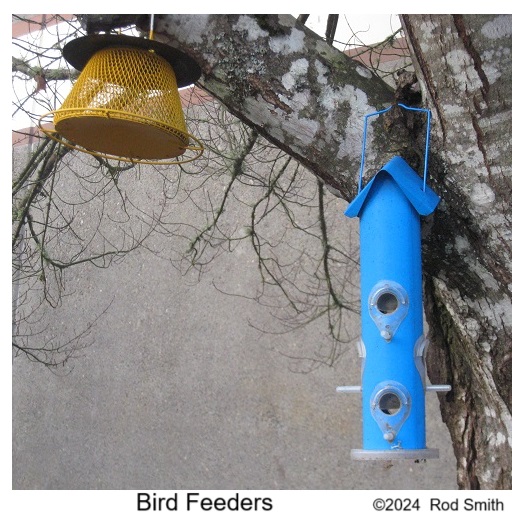 peanut butter are especially valuable in the winter when protein is scarce and birds need extra fat for warmth. Both can be spread on a pine cone, or blocks of suet can be placed in suet feeders.
peanut butter are especially valuable in the winter when protein is scarce and birds need extra fat for warmth. Both can be spread on a pine cone, or blocks of suet can be placed in suet feeders.
Feeders should be placed away from noise, traffic, rain and strong winds, but where they can be easily observed and maintained. Under the eaves or stuck directly on a window are good places. Clear plastic domes, or squirrel baffles, are good for keeping out rain as well as squirrels. One concern about placing feeders near windows is that birds might fly into the window if the reflection makes it look like an open escape route. Placing the feeder close to the window prevents birds from reaching full speed before crashing. Plastic decorations can be placed on the window to break up reflections. Another concern is predatory birds and cats. Placing the feeder about ten feet from a large shrub will provide nearby shelter from predatory birds while still providing some distance from stalking cats. Also, hanging a feeder above Oregon Grape will keep cats away.
Hummingbirds have special requirements for feeders and food plants. They are especially attracted to red or orange tubular flowers. Nectar plants include: Aquilegia Columbine, Brodiaea Firecracker Plant, Clarkia, Delphinium, Dianthus Sweet William, Dicentra Bleeding Heart, Gaultheria Salal, Gladiolus, Heuchera Coral Bells, Lavandula Lavender, Lilium Lily, Lobelia Cardinal flower, Lonicera Honeysuckle, Monarda Beebalm, Penstemon, Phygelius Cape-Fuchsia, Salvia Sage, Scabiosa Pin Cushion Flower, Fuchsia, Ribes Flowering Currant, Rubus Salmonberry, Weigela, Cornus Dogwood, and Malus Crabapple. Provide a combination of plants which produce flowers from spring through fall. Hummingbird feeders are helpful, especially for Anna's hummingbird which stays year-round. Bring feeders inside at night to prevent nectar from freezing when temperatures stay below freezing.
The Audubon Society has a list of native plants and the birds they attract at Audubon Native Plant Database.
Insects can be found on flowers, on vegetables, on weeds, on water and many other places. Beneficial insects will be attracted into the landscape by planting Achillea Yarrow, Ajuga Carpet Bugle, Anethum dill, Coriandrum Coriander, Daucus Queen Ann's Lace, Foeniculum Fennel, Linaria, Mentha Pennyroyal, Lobularia Sweet Alyssum, Monarda Beebalm, Penstemon and Potentilla.
Ladybug adults
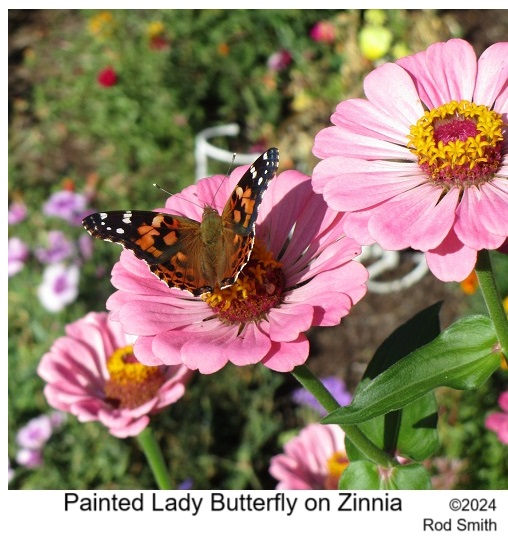 are red or orange with black spots. Ladybug larvae are the opposite: black with red or orange spots.
They will usually be found on the underside of leaves feasting on aphids. Larvae eat ten times as many aphids as adults.
are red or orange with black spots. Ladybug larvae are the opposite: black with red or orange spots.
They will usually be found on the underside of leaves feasting on aphids. Larvae eat ten times as many aphids as adults.
Adult butterflies and moths feed on nectar from flowers while the larvae, caterpillars, feed on leaves. Caterpillars and adults often feed on completely different plants. Some have very specialized food requirements, but some plants that attract a number of different butterflies and moths include: Asclepias Milkweed, Aster, Cirsium Thistle, Dianthus Sweet William, Erysimum Wallflower, Holodiscus Oceanspray, Leucanthemum Daisy, Mentha Garden Mint, Monarda Beebalm, Penstemon, Philadelphus Mockorange, Phlox, Prunus Cherry Plum, Rubus Blackberry, Solidago Goldenrod, Syringa Lilac, Taraxacum Dandelion, Trifolium Clover, Urtica Stinging Nettle and Salix Willow.
Pictures and descriptions of butterflies found in Oregon can be found at Oregon Butterflies
Pictures and descriptions of bees and related pollinators found in Oregon can be found at Guide to Common Pollinators in the Willamette Valley.
Mason bees are native bees which are much better at pollinating fruit trees than honey bees. They can be attracted to a landscape by providing a nesting block made by drilling 5/16 inch holes 3 inches deep a half inch apart in an untreated 4 X 4 about 8-12 inches long. It should be mounted out of the wind and rain, preferably exposed to morning sunlight. Mud or moist soil must be available. The holes will need to be cleaned every year or the block replaced every few years.
Dragonflies and damselflies are often seen over ponds or streams catching insects. Dragonflies' preferred prey is mosquitoes while damselflies prefer aphids. The nymphs of both dragonflies and damselflies feed on small aquatic insects including mosquito larvae.
Garden spiders make the large, round spider webs. They are not poisonous to people and they are very effective at capturing flying insects which can be very annoying.
Garden perennials which provide nectar for both butterflies and hummingbirds include: Armeria Seathrift, Aruncus Goat's Beard, Brodiaea Firecracker Plant, Campanula Bellflower, Delphinium, Dianthus Pinks, Echinops Globe Thistle, Erigeron Fleabane, Erysimum Wallflower, Gaillardia Blanket Flower, Iris, Liatris Gayfeather, Lilium Lily, Lupinus Lupine, Monarda Beebalm, Nepeta Catmint, Penstemon, Phlox Tall phlox, Rudbeckia Black-eyed Susan, Scabiosa Pincushion Flower, Solidago Goldenrod and Verbena.
Garden annuals which provide nectar for both butterflies and hummingbirds include: bachelor buttons, calendula, cleome, cosmos, delphinium, nasturtium, sage, sweet alyssum, sweet pea, verbena, and zinnia.
Wildflowers which provide nectar for both butterflies and hummingbirds include: Allium Nodding Onion, Angelica, Asclepias Showy Milkweed, Camassia Camas, Campanula Bellflower, Castilleja Paintbrush, Clarkia, Delphinium, Dianthus Sweet William, Gaillardia Blanket Flower, Lupinus Lupine, Lythrus Sweet Pea, Mimulus Monkey Flower, Sidalcea Checker Mallow, Solidago Goldenrod and Vicia Vetch.
Descriptions of these plants can be found in Oregon Wildlife Landscape Plants and at http://rodsgardening.com/perennials.htm. Common names and scientific names can be found at http://rodsgardening.com/common.htm.
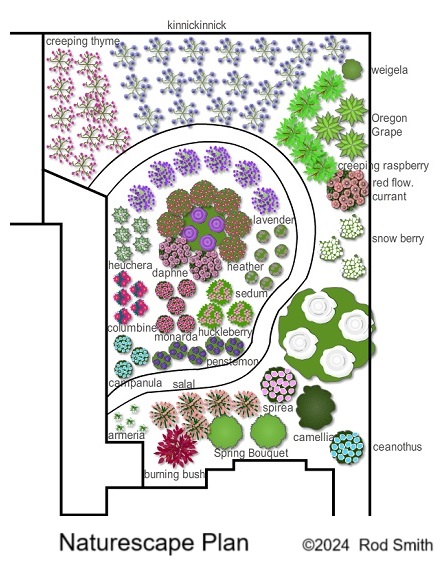 Naturescape Planting Plan was for my customer who wanted to replace his front lawn with a landscape which needed less maintenance and less water. The dead sod was used to make two mounds for planting trees. Flowers are chosen to attract hummingbirds and butterflies. Native shrubs are placed along the far side of the yard.
Naturescape Planting Plan was for my customer who wanted to replace his front lawn with a landscape which needed less maintenance and less water. The dead sod was used to make two mounds for planting trees. Flowers are chosen to attract hummingbirds and butterflies. Native shrubs are placed along the far side of the yard.
Much of the information in this article was drawn from Landscaping for Wildlife in the Pacific Northwest by Russell Link, published by University of Washington Press. It contains much more detailed information on wildlife, habitat and ponds, as well as plans for building birdhouses.
Another great source of information is Naturescaping by the East Multnomah Soil and Water Conservation District which can be found online at Naturescaping Workbook.
Naturescaping Plants for Wildlife
Oregon Invasive Plants
Oregon Native Landscape Plants
https://www.audubon.org/native-plants
Audubon Native Plant Database
Oregon Butterflies
Guide to Common Pollinators in the Willamette Valley
Pest Control
Common and Scientific Names
Home Page
Site Map